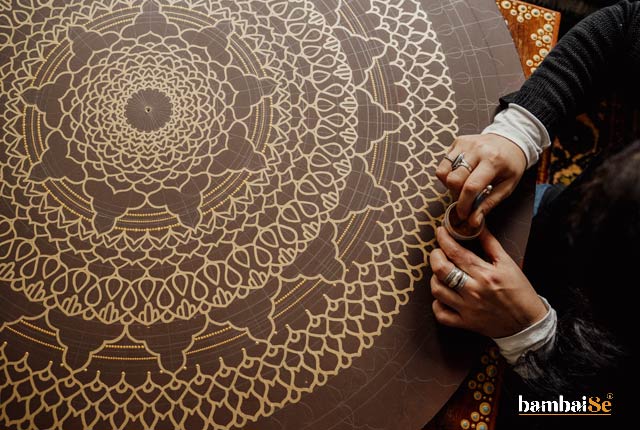Architecture is more than just buildings; it's a form of art that shapes our surroundings and affects our emotions. One fascinating way architects bring harmony and balance into their designs is by drawing inspiration from mandalas. These intricate circular patterns, often associated with spiritual significance, have found their place in the world of architecture.
What is Architecture?
Architecture, in the context of buildings and structures, refers to the design and planning of spaces that serve specific functions. It involves the creative process of arranging elements such as layout, materials, aesthetics, and functionality to create a harmonious and practical living or working environment. Architectural design takes into account factors like the intended purpose of the space, the surrounding environment, structural stability, cultural influences, and user needs. The resulting architecture can vary greatly in style, from traditional to modern, and can range from residential homes to towering skyscrapers.
Architecture also has the power to inspire and delight — it can enhance everyday experiences.
What is a Mandala?
Before diving into its influence in architecture, let's understand what a mandala is. A mandala is like a fancy pattern that starts from the middle and spreads out in a really neat way. Think of it like when you drop a pebble into water and the ripples go outward. These patterns can be found in art and even in nature.The word "mandala" comes from two parts: "mand," which means to mark or decorate, and "la," which means circle or sacred center. Mandala's meaning goes way back to ancient Indian temples. These temples used circles and squares to represent time and space, making a connection between people and the universe. Think of a mandala like a picture that helps people see the universe and where they fit in it, usually with a god or goddess at the center.It's a symbol used in various cultures, like Hinduism and Buddhism, to depict the universe's harmony.
Translating Mandalas into Architecture
What is the use of mandala in architecture?
Translating mandalas into architecture involves incorporating the visual and symbolic elements of mandalas into building design. You can draw inspiration from mandala patterns, symmetry, and spiritual significance to create structures with balanced layouts, intricate details, and a sense of harmony. Integrating circular motifs, radial layouts, and repeating geometric shapes can help capture the essence of mandalas in architectural designs. Architects often draw inspiration from mandalas to create spaces that evoke a sense of peace.
Examples of Structure Based Mandala-Inspired Architecture
Taj Mahal, India:
One of the most iconic examples of mandala-inspired architecture is the Taj Mahal. This majestic mausoleum features a symmetrical layout with a central dome and surrounding minarets. The intricate marble inlay work on the walls and floors resembles the radiating patterns of a mandala, evoking a sense of unity and balance.
Lotus Temple, New Delhi:

The Lotus Temple's unique lotus-shaped architecture is an example of modern design influenced by mandala concepts. The temple's layout incorporates radial symmetry, with petals extending outward from a central gathering space. The structure evokes the idea of a blooming lotus and provides a peaceful environment for meditation and reflection.
Borobudur Temple, Indonesia:

The Borobudur Temple is a UNESCO World Heritage Site known for its stunning mandala-like structure. This massive Buddhist temple consists of nine stacked platforms, each adorned with intricate relief carvings that tell a spiritual story. The circular path that pilgrims take while ascending the temple mirrors the journey toward enlightenment often associated with mandalas.
ISKCON, Vrindavan Krishna Temple, India:
The intricate mandala designs can be seen on the ceilings, walls, and floors of Krishna temple in India. These designs are not only ornamental but also hold spiritual significance. Devotees often meditate on the center of the mandala, focusing their attention on the divine energy it represents.
Mughal Gardens, India:

Some Mughal gardens, such as the Shalimar Bagh in Srinagar, feature layouts that incorporate mandala-like patterns. These patterns are often reflected in the pathways, water channels, and flower arrangements. The garden's design symbolizes the unity of nature and the harmony between human creations and the environment.
Tibetan Buddhist Monasteries:

Tibetan monasteries are known for their intricate mandala paintings created using colored sand. These mandalas are meticulously constructed during rituals and serve as temporary works of art before being ceremoniously dismantled. The process symbolizes impermanence and the transient nature of existence.
Examples of Architecture with mandala inspiration
Islamic Geometric Patterns:
In Islamic architecture, intricate geometric patterns are used to create mesmerizing designs often reminiscent of mandalas. These patterns are seen in the intricate tilework of mosques, madrasas, and palaces, representing the infinite nature of creation and the divine order of the universe.
Sri Yantra-inspired Architecture:
The Sri Yantra is a sacred geometric pattern revered in Hindu and Buddhist traditions. Some contemporary architects draw inspiration from this intricate design to create buildings with geometrically precise layouts and interconnected spaces. These structures not only pay homage to the spiritual significance of the Sri Yantra but also offer functional and visually appealing spaces.
Gothic Rose Windows:

Rose windows in Gothic cathedrals, like the famous Rose Window in Notre-Dame Cathedral, feature radiating designs that draw inspiration from mandalas. These ornate stained glass windows are not only architectural marvels but also convey spiritual stories and symbolism.
Conclusion
In conclusion, the incorporation of mandala art into architecture brings forth a captivating fusion of beauty and functionality. By embracing the principles of unity, symmetry, and balance, architects can create spaces that resonate with deeper meanings while also serving practical purposes. Whether through historical monuments or modern designs, the influence of mandalas in architecture continues to captivate and inspire, reminding us of the profound connection between art and the spaces we inhabit.
We at bambaiSe create home décor accessories with mandala art designs as we believe that home is a place where one finds peace & relaxation after a hard working day. All our products are designed with Traditional Indian Mandala Art & minimal colors to give your space a modern look yet have a traditional feel.





Leave a comment
This site is protected by hCaptcha and the hCaptcha Privacy Policy and Terms of Service apply.